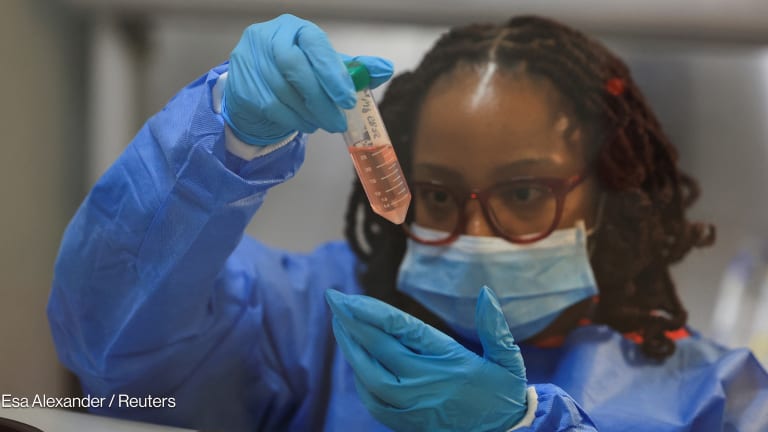
GENEVA — The global health community is increasingly moving away from a siloed approach — favored in the height of the battle against HIV/AIDS, tuberculosis, and malaria — toward a more integrated methodology in the spirit of the Sustainable Development Goals.
Unitaid, a Geneva-based organization that invests in new ways to prevent, diagnose, and treat the three pandemics, is one of the actors leading this paradigm shift alongside innovators from the private sector, governments, and donors.
In April, Unitaid launched a call to improve fever diagnosis in children in low-resource countries, a potentially game-changing investment aimed at boosting malaria response while fighting drug resistance.
According to estimates, more than 75 percent of children seeking care have fever, the main symptom of malaria. Once this disease has been ruled out, misdiagnosis of fever — which can have many different causes — is common. This leads to children receiving the wrong treatment and can result in the misuse of antibiotics, which fuels resistance to the most common drugs.
Sanne Fournier-Wendes, senior adviser to Unitaid’s executive director, explained to Devex how the organization is engaging with the private sector to push forward an integrated approach to global health; what their strategies are to help vital innovations overcome market barriers; and why public-private partnerships are set to play a crucial role in the global health response going forward.
The conversation has been lightly edited for length and clarity.

As part of a more integrated approach to global health, Unitaid is investing in child fever management and multiplatform diagnostics — devices that can be used to screen various diseases. Why is it critical to support innovators in these areas at this moment in time?
Fever management in children under 5 is an under prioritized area which falls through the cracks of many different disease areas. And, over the last 15 years, the global health community has responded in a very siloed way — a given program would only look at malaria, HIV or tuberculosis.
For years, manufacturers were faced with that barrier. For instance, they might come up with a TB diagnostic system that could also be applied to HCV — hepatitis C virus — but they would be told: “Sorry, we cannot support this because our program is only looking at TB.”
More on global health:
► Tuberculosis and NCDs jostle for space in global health agenda
The world is starting to move away from that, and to understand we need to capitalize on the investments we have made in siloed programs to make a broader health impact.
Now, we are asking ourselves how we can apply the available technologies across the board, and that is where multiplatform diagnostics come in. To continue developing new products, innovators in the field of multiplatform diagnostics need to see this shift among funders. They also need to confirm there will be a market for these diagnostics going forward.
How are you engaging or planning to engage with the private sector to catalyze innovation, particularly in child fever management?
Child fever management is a hugely exciting area for us to get involved in because it takes us beyond the three diseases — malaria, HIV, and TB — and looks at the patient in a holistic manner, instead.
We recently launched a call for proposals to diagnose severe disease in children through devices that can, for example, identify those who need oxygen therapy.
These innovations are being developed by the private sector — so we engage with them at different levels. Before launching the call, we engaged with the industry to conduct a technology landscape analysis. The aim was to understand what is in their pipeline, what research and development they are working on, and which technologies are closer to the market, as well as the challenges they see in launching them.
So many of the proposals will be about implementers working with the industry, both to bring new technologies forward and to see how they can be implemented in low-resource settings.
What are the key barriers in the innovation chain for child fever management, and how do you plan to address them?
One of the main challenges with these technologies is that they are mostly used at a centralized level instead of at the point of care — that is, in health facilities rather than close to where the patients are.
What we are looking into now is how to bring these devices to very low-income settings — for example, places without electricity or highly qualified health staff.
There are challenges in adapting the products and making sure they are easy to use, as well as in establishing which products work where. The World Health Organization needs that evidence to be able to update guidelines and make recommendations.
Should the price of products be an issue, we could address it from different angles. If there is a monopoly, we might try to bring in several suppliers that would bring the prices down.
Another aspect affecting prices is the absence of forecasting, manufacturers cannot see what the global market might look like. In these cases, we might analyze the market potential by aggregating the demand in various countries, and then take that figure to the industry for them to reassess the prices.
Beyond analyzing what innovations are in the pipeline, do you take action to help shape the research and development agenda of the industry and how?
Absolutely, we do lots of efforts to reach out and we have ongoing consultations and discussions with the private sector. To draft our 2017-2020 strategy, we conducted a very broad consultation that included the private sector. Through our strategy and the development of broader areas of intervention, we show that we are shifting away from siloed approaches, and that we are very much focused on integration across the board.
So yes, we interact with the private sector to help it understand there is an appetite to go beyond the approaches we see today.
Unitaid chairs a working group on innovation and access for the United Nations’ Interagency Coordination Group on Antimicrobial Resistance. How can investments in innovation and research be harnessed to respond to antimicrobial resistance, and what role should the private sector play?
A big challenge behind antimicrobial resistance is that it is very broad — it is about antibiotics, but also about antiparasitics and antivirals. Not only does it cover medicines, but also diagnostics and vaccines because they all play an integrated role in resistance through a “one health approach” — merging human, animal, and environmental health.
We need new antibiotics, there is no dispute about that, and the private sector has a big role to play here. Not only the large pharma companies, but also smaller biotech firms. They are often the ones coming up with novel ingredients and conducting the basic research that feeds into the pipeline of the pharma industry.
This means we need to look at how to incentivize development of new products across the whole value chain. Then, there is the issue of ensuring responsible access to antimicrobials.
How are the group’s recommendations to the IACG expected to influence policies and practices concerning AMR?
The IACG is mandated to produce a report to the U.N. secretary-general for the General Assembly in September. Hopefully, the recommendations will be bold enough to guide future investments on this really important topic, including innovation and access.
Over the next five years, which role do you expect public-private partnerships to play in the global health sector, especially amid the greater push for domestic funding?
They are absolutely crucial and will play a very important role going forward, particularly in catalyzing public investments.
In the last two decades, countries were faced with national emergencies and international donors stepped in to support them. We are now moving away from that in many countries, and we need to build sustainable health systems instead.
We need to think differently about how international funding can help catalyze domestic funding. PPPs motivate and incentivize manufacturers to bring new products to the market in under-prioritized areas. This will help countries access better solutions and get more out of their domestic funding.
Devex, with financial support from our partner MSD for Mothers, is exploring how the private sector is driving innovations in global health. Visit the Focus on: Future of Health Partnerships page for more.








